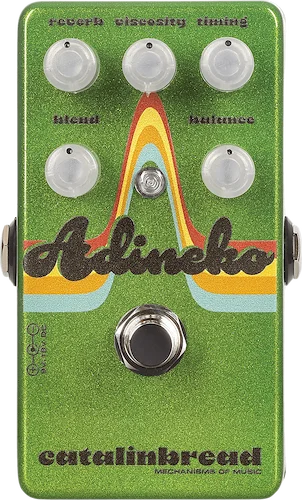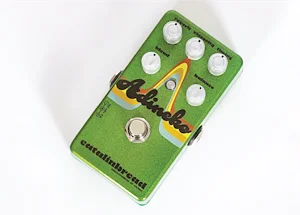Catalinbread Adineko 70's Edition




Product Description
Oil can delay units were manufactured by a company named Tel-Ray who later became better known as Morley. Tel-Ray mostly focused on being the OEM utilizing their oil can technology (Patent US3530227 A), branding units for Gibson (GA-RE4), Fender (Dimension IV), Acoustic, etc. They employed an electro-static storage method where the signal is “recorded” to a spinning disk, a layer of oil (for years rumored to be a mysterious carcinogenic oil) prevented this signal from leaking into the air before a “pickup” moments later played back the signal recorded to the disk. Compared to the counterparts of the day (tape, drum, wire delay machines), their sound was more low fidelity, murky, often with a more consistent musical vibrato that correlated to the spinning disk speed. We like to describe the sound as mysterious. The Catalinbread ADINEKO pedal is an echo, reverb, vibrato pedal that faithfully models the sonic experience of these oil can units.
Product Features
- REVERB: This knob functions like the repeats on any echo unit; it feeds back the wet output back into the input of the delay line. On oil can delays and the ADINEKO, the repeats quality smears into a soupy, foggy texture due to the low fidelity of the record medium and the fact that the echoes are always modulating.
- BLEND: This control allows you to mix between 100% wet and 100% dry signals. The original units featured tube preamp stages; the ADINEKO’s preamp stages are tuned to provide very much the same experience as a healthy example of an original unit.
- VISCOSITY: Controls the modulation depth.
- TIMING: A majority of original oil can units have a fixed rotation speed, hence a fixed delay time and fixed vibrato time (there were models with a mechanical motor brake to slow it down); however, the actual maximum delay time was very short, ranging from 80-120ms. The ADINEKO extends your modulated delay time up to one second.
- BALANCE: Original units had a short and long echo playback head selectable by a pair of slider switches or a rotary switch that allowed the user to select one or the other, or both on at the same time. We expanded upon this concept by putting the playback heads on a continuous mixer, allowing accents and new rhythmic possibilities by favoring one head volume over the other. Counter-clockwise is the short delay time head, clockwise is the long head, and noon is both heads at equal amplitude.